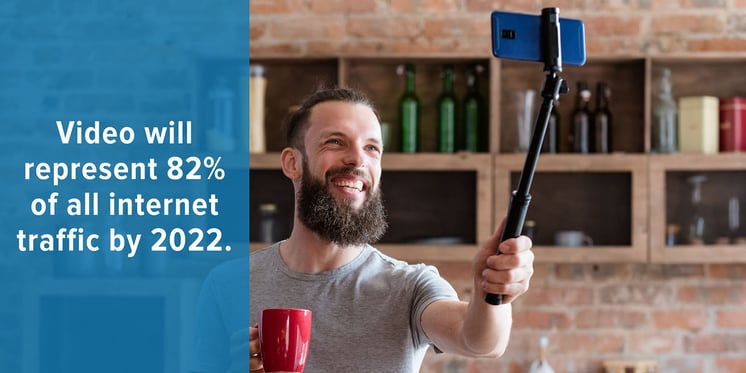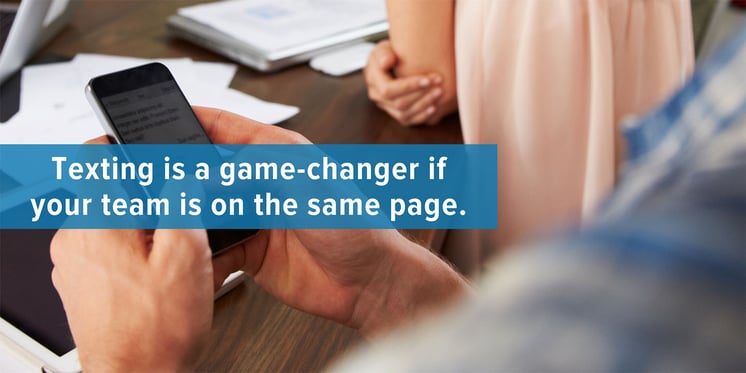/Blog-Unlock_CRM_Success_Whiteboard_Mortgage_CRM.png?width=1920&name=Blog-Unlock_CRM_Success_Whiteboard_Mortgage_CRM.png)
Matt Brown smelled an opportunity. Interest rates were among the lowest in years. Plus he had a CRM full of customers. How could he capitalize on this?
Turns out it was pretty easy.
With just three clicks in his CRM, Matt identified a list of 489 people based on their interest rate and date funded. From there, he created an automated text message targeting the list.
“We worked with you on your home loan. Have you considered refinancing to lower payments?”
Within minutes, nearly 500 people received his text.
Within the first day, eight people replied back with some variation of “I was just thinking about that. Let's talk!”
By the end of the week, Matt received 12 applications, all by sending one text from his CRM. One text, sent one time—that’s ROI.
Like Matt, you have a lot of potential power in your CRM if you know how to use it. And while your mileage may vary, opportunities to create value (and sales) are everywhere. We’ll show you ways to maximize your CRM whether you’re a team of one or 100.
1. Focus on that one thing
It’s tempting to jump into your software with a laundry list of things to accomplish. So many problems to solve, so little time. But let’s be honest, your CRM is not a magic bullet. It won’t suddenly solve all your sales, marketing, and relationship problems.
In fact, an average of one-third of CRM projects are failures.
The reasons for failure can be boiled down to four main areas: people, process, strategy, and technology, according to research by Forrester. From user adoption to poor definition of requirements to an absence of objectives, each area lacks one thing that could help alleviate all of these issues—focus.

If you try to solve all your problems at once, you’ll end up spreading yourself—and your team— too thin. It’s the same reason you don’t want to try more than one audacious personal goal at the start of a new year.
Lose 30 lbs? Yes. Lose 30 lbs., find your dream job, and travel the world? Probably not a good combo. Each on its own will be challenging. Trying all three at the same time will only water down your efforts to achieve one goal, let alone the trio.
Instead, focus on one thing at a time. To start, make a list of what’s most important to you. In other words, why do I have a CRM? Or why do I want a CRM? (if you’re still looking) Here are some answers we commonly hear:
- Manage my current pipeline of leads and deals
- Help me cultivate partnerships
- Leverage my funded database for refi’s, referrals, and reviews
- Automate routine tasks
- Track communication with partners and customers
Then rank your list in priority starting with the one thing that is most important to you. By focusing on this one thing, you will find success faster. It will also allow you to be more flexible as your priorities change.
2. Evolve your definition of ROI
You should always be evolving your definition of ROI and what you want from your CRM. Keep asking yourself what’s most important now. It may be a different set of priorities than when you first started. Most likely it will be. Then accomplish that one thing. Reevaluate. And move on to the next most important thing.
3. Embrace video now, not later
According to a Cisco study, video will represent 82% of all internet traffic by 2022. It will dominate all other types of traffic—web, email, gaming, and file-sharing. Video can feel intimidating to the uninitiated. But it’s easy to get started—and the most important thing is to get started. Don’t worry about being the next Scorcese and De Niro.
What video platform you use isn’t important. Try YouTube, Vimeo, Wistia, BombBomb. It really doesn’t matter. The only thing that matters is you have a link your contacts can click to watch the video. We’re not going to show you how to make a video because that’s an entire article by itself. But we will show you the types of video to automate and scale.

Which types of video to automate
You can classify your videos in two ways. There's the personal, in the moment video: “Hey, Joe, happy birthday!” or “Hey, Joe, congrats on getting funded!” These are very personal and specific.
Then there's the repetitive. “Hey Joe, I just wanted to let you know your appraisal came back. Everything looks good! We’ll talk soon.” These are the tasks and the milestone updates that are automatic for you because you do them regularly. And they should also be automated.
If you stripped the customer’s name out of the video, you could save yourself time for these otherwise repetitive messages. Try recording something like this: “Hey, it's Mitch from Mortgage Monster. I just wanted to let you know that we got the appraisal back and things are looking good. More to come.” This could then be used for all of your appraisal notifications—at least the positive ones.
If you recorded each update one time, you just saved 30 seconds times however many loans, multiplied by the number of customers. Then do the same for holidays and birthdays, sending the links in emails and texts.
For personalized one-offs, record videos individually. “Hi Lucy, congratulations on the birth of your daughter! That’s awesome! Our team is thinking of you.”
Each video type has its place, so use them both. Figure out where repetitive videos can be used, record the, and automate sending them out en masse. Save one-off recordings for those very personalized events.
4. Reduce your support frustration
Sometimes people will buy a product for the promise of the product. You buy a vacuum to keep your floors clean. But you stay because of your relationship with the vendor.
In one survey, 78% of respondents said the quality of their customer service interactions were a determining factor to purchase a brand’s products or services again.
Because CRM software is complex, it’s unrealistic for vendors to expect their clients will be experts. Being an expert is the vendor’s job. However, both parties—vendor and client—have responsibilities in the relationship.
The vendor should be staffing their support team with professionals who can not only resolve issues but also add value, helping you become more successful with the software. Too often, companies hire and pay their agents as if they were just cogs in a machine.
As a client, you can reduce your frustration with support by giving them all the information you can. What do you think of these questions?
- “We have created a mass email campaign. Did we do it wrong?”
- “Why can’t I get this report to run?”
- “What’s going on with the weird error message I’m getting?”
Not great, huh? There’s going to be needless back and forth before the support agent can even start troubleshooting. With just a few identifying details (What campaign? What report? What’s the error message?) these support questions could be answered faster and with less frustration.
Another way to ease your exasperation is to familiarize yourself with the self-help tools available. It’s a rare CRM vendor who is available 24x7x365 to answer your questions, and you’re likely going to pay a hefty premium for the ones that are! Get familiar with their knowledge base. Most vendors will have articles and videos to walk you through just about anything the CRM can do, or at least point you in the right direction to figure out how to accomplish your goal.
Finally, think about your level of urgency. Is this a hot fire that must be solved immediately? Or just a suggestion you wanted to share? The priority of your issue should determine which communication channel you opt for.
With email, you can expect a reply in several hours and sometimes it’s even the next business day. Use this if your problem can wait up to 24 hours. Live chat—all vendors should have this as an option—allows you to chat quickly with support while you are handling other tasks. It’s not quite like phoning in, but it’s the next best thing and preferred over all other channels for support.
Pick up the phone if it’s something that needs immediate attention. And be prepared to provide as many specifics as possible to avoid the back and forth. You’ll reduce frustration for you and the support team.
5. Maximize texting to automate and collaborate

Most people we talk to handle their entire texting conversations with their borrowers and partners on their phones. That is, using the same app they use to text their family and friends. This isn’t ideal and here’s why.
You likely have one or more people who work with you. Say a borrower calls the office and talks to a team member who answers their question. But unbeknownst to your teammate, you were already working on the same question via text. So you spend time getting the information to the borrower only to learn your co-worker talked to them an hour ago.
That’s called collision and something to avoid with your team members.
If you use your CRM (or something like Google and RingCentral) for texting, everyone on your team will have visibility to conversations, giving your team one portal everyone can use to collaborate.
Another valuable texting function is communication automation. Like we discussed with automating video, texting can be used to scale repetitive events. So, rather than sending hundreds of individual texts, you’ll create one text for each event and send them automatically based on a trigger such as the completion of an appraisal or a birthday.
Texting in action: re-target for Refi
One of our California clients asked us to help create a refi campaign using texting. He wanted to identify mortgages with an interest rate of 4.0% that were funded before a particular date. Instead of spending his weekend sifting through Excel sheets to identify these clients, we helped him set up a campaign in his CRM to do it for him automatically.
With a few clicks, we identified hundreds of clients who were good targets based on the criteria. The client wanted an even smaller list so we revised the interest rate and funding dates, whittling down the number of results. A good CRM will allow you to easily create and update triggers like this to refine your audience, write a text, and then send that text en mass.
For this client, we ended up whittling it down to 55 people that he wanted to target as an experiment. And he got four loan applications within the first hour.
Putting it all together
Think of your CRM as an investment and how you can maximize ROI. Even if you’ve been using the same CRM for five years, decide on the one thing that is most important to you right now. Focus on that. Then reevaluate your priorities and move on to the next most important thing.
If you’re not using video, start. It’s only going to get more popular in the coming years. Pick a platform and then start to automate the repetitive events.
Remember that support is a two-way street. There’s a lot of potential value there if you use it wisely. Familiarize yourself with your vendor’s self-help materials and if needed, use the support channel that matches your level of urgency.
Texting is a game-changer if your team is on the same page. Use texting software that allows collaboration with your teammates and not collision. Automating repetitive tasks will save you hours of time.
Lastly, use your texting and video capabilities to run refi campaigns. For a relatively small investment of time, you can send messages to a targeted list of customers that may benefit from a refi based on their rates.



